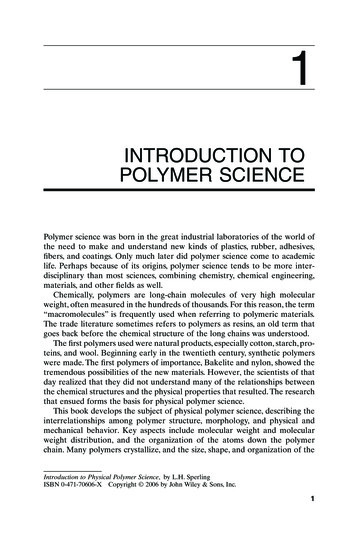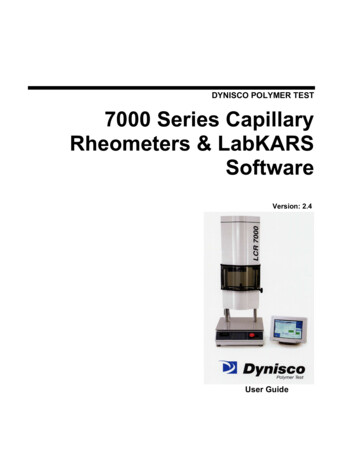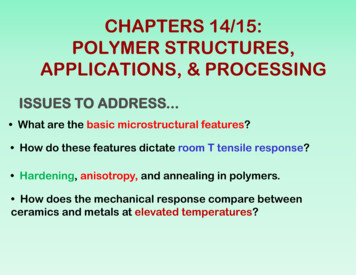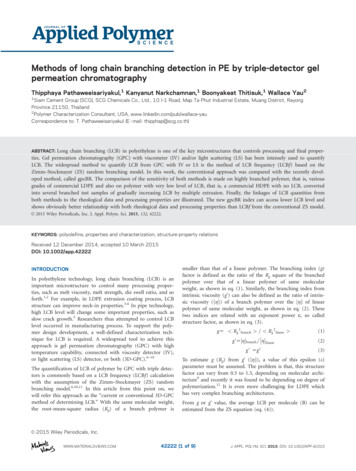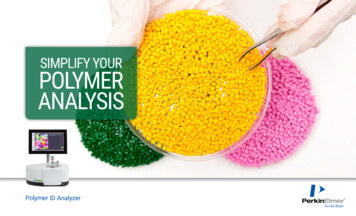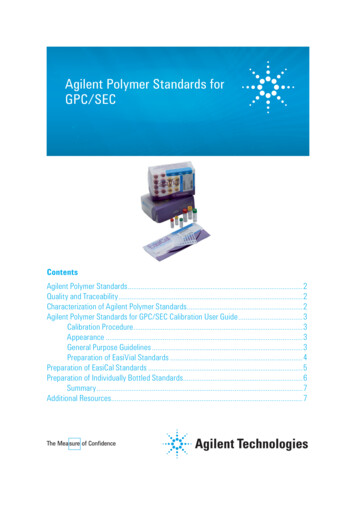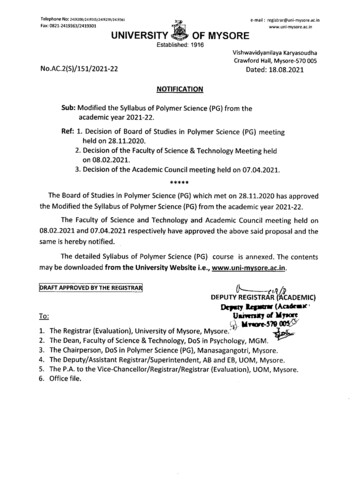
Transcription
2021-2022ೖಸೂರುಶಾ ಲಯM.Sc. POLYMER SCIENCEChoice BasedCredit System(CBCS)
UNIVERSITY OF MYSOREDepartment of Studies in Polymer ScienceManasagangothri, Mysuru-570006Regulations and SyllabusMaster of Polymer Science(Two-year semester scheme)UnderChoice Based Credit System (CBCS)
UNIVERSITY OF MYSOREGUIDELINES AND REGULATIONSM.Sc. POLYMER SCIENCE(TWO-YEAR SEMESTER SCHEME UNDER CBCS)Programme DetailsName of the Department: Department of Studies in Polymer ScienceSubject: Polymer ScienceFaculty: ScienceName of the Course: Master of Polymer ScienceDuration of the Course: 2 years - divided into 4 semestersCBCS & CAGP Syllabus and Credit Pattern (70 15 15)Eligibility for admission to M.Sc., in Polymer ScienceB.Sc. Degree with Chemistry/Polymer chemistry/Biochemistry as one of thesubject with minimum of 50% marks for General Merit (GM) Candidates and 45%for SC/ST Candidates.OrB.Sc. Degree with Add – on Diploma in Chemistry /Polymer chemistry/Biochemistry
Syllabus for M.Sc, Polymer Science Entrance ExaminationChoice –Based Credit System & Continuous Assessment and GradingPattern(CBCS-CAGP)Eligibility for Admission to M.Sc in Polymer ScienceB.Sc. Degree with Chemistry/Polymer Chemistry as one of the Subject with a minimum of 45%marks in Chemistry/Polymer Chemistry for General Merit (GM) candidates and 40% for SC/STcandidates.SyllabusUnit 1: History of macro molecular science, importance of monomers and polymers, basicconcepts. Nomenclature of polymers, inter molecular forces and chemical bonding in polymers.Classification: addition polymerization, condensation polymerization, polymerization mechanism.Unit 2: Techniques of polymerization: Bulk, solution, suspension, emulsion, co-ordinationpolymerization, ring-opening polymerization, co-polymerization, importance of molecular weightin polymers, molecular weight distribution, control of molecular weight and their determination.Unit 3: Bonding in organic molecules- Hybridization, sigma, pi and conjugated bonds, takingethane, ethene, ethyne, Butadiene and benzene as examples. Bond energy, bond length and bondangles. Concept of resonance, resonance energy.Unit 4: Stereochemistry: Chiral concepts, D, L; R, S nomenclature. Geometrical isomers: E and Znomenclatures, Classification of organic reagents and reactions: Nucleophiles, electrophiles,nucleophilicity and electrophilicity. Mechanism of SN1 and SN2 reactions, carbonium ions,carbanions and free radicals formation and stability.Unit 5: Addition to carbon carbon double bonds, catalytic hydrogenation. Naming reactions likeAldol condensation, Claisen condensation, Grignard reaction, Beckmann rearrangement.Unit 6: Thermodynamics: Laws of thermodynamics, spontaneous and non-spontaneous reactions.Gibbs free energy, relation between entropy and thermodynamic probability. Partition functions.Partial molar quantities: partial molar free energy. Thermodynamics of dilute ideal and non-idealsolutions.
Unit 7: Chemical kinetics: Transition state theory. Reaction in solution: collusion theory andtransition state theory. Salt effects. Effect of pressure and dielectric constant on reaction rates.Electro chemistry: Debye-Huckel theory of strong electrolytes, Onsager equation, Debye- Huckellimiting equation for activity coefficient, electrical double layer, electro capillary and electrokinetics phenomena.Unit 8: Chemical bonding in inorganic compounds, coordination compounds, catalysis, aqueousand non aqueous solutions, s, p, d, molecular orbitals and their shapes. Heisenberg uncertaintyprinciple. Atomic orbitals, Schrodinger wave equations, Quantum numbers, Aufbu and PauliExclusion Principle, Hund’s multiplicity rule, electronic configuration of the elements. Atomic andionic radii, ionization energy, electron affinity and electro negativity.Unit 9: Chromatography: general terms and parameter used in chromatography, classification ofchromatographic methods. Stationary and mobile phases- nature of adsorbents, factors influencingthe adsorbents, nature and types of mobile phases. Column chromatography and thin layerchromatography: principle and applications.Unit 10: Need for testing, standard and specifications. National and international standards, qualitycontrol, accuracy and validity of best methods. Recycling and biodegradability methods.References:1.2.3.4.5.6.7.8.Chemical kinetics – K. J. LaidlerThermodynamics- Kuriacose and RajaramThermodynamics- S. GlasstoneAdvanced Inorganic chemistry by J E .Huheey.Advanced Inorganic chemistry by FA Cotton and G.WilkinsonOrganic chemistry- Morrison and Boyd (Prentice Hall)Text Books of Polymer Science – Bill Meyer (Wiley Inter Science Publishers)Polymer Science – V R Gowarikar
Ph.D. Entrance ExaminationSyllabusUnit 1: General- Introduction to polymers with emphasis on important concepts such as –monomers, functionality and physical state ( amorphous and crystalline), classification of polymerson the basis of source, elemental composition, heat, pressure, chemical reactivity,chemical/monomer composition, geometry and stereo regularity. Nomenclature of polymers.Unit 2: Chemistry and Mechanism of polymerization- Definition of polymerization, factorsaffecting on polymerization, Addition polymerization (free radical, ionic and n. Living radical polymerization.Co-polymerization- Co-polycondensation, plasma polymerization, photo polymerization, Electrochemical polymerization, Metathesis polymerization, Group transfer polymerization, ATRP,Reversible addition-fragmentation chain transfer polymerization, dendrimer.Unit 3: Specialty polymers- Functional polymers, LCPs, Conducting polymers, degradablepolymers, Engineering Polymers: Unsaturated polyester resin, Epoxy resins, phenolic resins, Aminoresins, Alkyds. Properties and applications of engineering polymers: Nylons, polyesters, PAN, PC,PU, ABS, Polyacrylates and allied polymers, Fluoropolymers, modification of industrial polymers.Unit 4: Concept of polymer molecular weight: Importance of molecular weight control.Arthemitic mean-molecular weight, Weight average molecular weight, Mw, number –averagemolecular weight, Mn and viscosity average molecular weight Mv. Molecular weight distributionand its importance from the point of applications.Determination of molecular weight- End group analysis, cryoscopic method, ebulliometricmethods, membrane osmometry, vapour phase osmometry, light scattering, ultra centrifugation &viscometry.Unit 5: Polymer processingProcessing of polymers: Moulding-compression moulding, injection moulding, blow moulding,rotational moulding, thermoforming, Extrusion-coextrusion, film extrusion, pultrusion, calendering,casting, coating. Reaction injection moulding (RIM) - principle and Moulding of DMC and SMCand other thermoset processing operations.Unit 6: Polymer TestingMechanical properties: Tensile properties, compression properties, flexural properties, shearproperties, impact resistance, toughness, tear resistance, abrasion resistance and hardness, creep,stress relaxation, fatigue properties, flexing and resilience.Flammability properties: Oxygen index, critical temperature index, smoke density, flammabilitytest, ignition properties, and surface burning characteristics.
Electrical properties: insulation resistance, volume resistivity, surface resistivity, breakdownvoltage, dielectric strength, arc resistance, dielectric constant, power factor.Optical properties: gloss, haze, refractive index and degree of yellowness, transmittance,photoelectric properties, and color.Miscellaneous properties: MFI, MVI, specific gravity, bulk density, ESCR, weathering properties,toxicity, resistance to chemicals, abrasion, tearing, coefficient of friction, VST, HDT,Nondestructive testing methods.Unit 7: Spectroscopic Methods: UV-visible spectroscopy- principle & theory Applicationsqualitative and quantitative analysis, purity, cis-trans-conformation, molecular weight determination.Polymer degradation analysis.Fourier transform infrared spectroscopy: principle and theory. Applications- Establishment ofchemical structure of polymers, reaction kinetics, polymer linkages, hydrogen bond formation,purity, copolymerization, qualitative and quantitative results.Nuclear magnetic resonance spectroscopy: (1H and 13C NMR) principle, theory, applicationsstructure (chemical), purity, tacticity, etc.Unit 8: Thermal methods:DSC: theory, principle& interpretations of DSC thermogram, Applications- heat of fusion anddegree of crystallinity or isotacticity. Random copolymer structure, Block copolymer structure,polymer mixture melting point depression by diluents, crystallization, melt crystallization, coldcrystallization, Tg, Tm, determination of blend composition, purity, identification of unknown,degree of crystallization, degree of cure, rate of cure studies( kinetics of curing) plasticizer effect, (Broido method, Kissinger method, Ozawa method, R& D method).Thermogravimetric analysis: Principle, theory, Applications-purity, fiber content composition ofcompounded rubber, identification of polymers and rubbers, thermal stability, thermal degradation,kinetics of thermal degradation, IPDT, etc, Principles of DMA and TMA-applications.Unit 9: Chromatographic Technique: Gel permeation chromatography-theory, principles,Applications-qualitative and quantitative analysis, molecular weight determination and molecularweight distribution, purity, composition, polymerization kinetics, depolymerization, identificationof unknown, etc.X-ray diffraction: SAXS, WAXS, theory, principle, Application- chain conformation, chainpacking, disorder in crystals, degree of crystallinity, microstructural parameters, degree oforientations. Principles of optical microscopy, SEM, TEM, AFM. Applications- Methodology ofpolymers, crystallization behavior, phase separation.Unit10: Structure -property relationshipPolymer properties- Approach and the concept. Chemical structure of polymers - Introduction.Shapes and energy consideration, copolymers, heteroatomic polymers, physical structure ofpolymers- introduction, melt viscosity, interchain and interchain forces, glass transitiontemperature, crystallinity, elastomers, fibers, plastics and their correlation with Tg and Tm
(structural features). Physical properties of polymers in relation to chemical structure: volumetricproperties- volume and density, thermal expansion, calorimetric properties- heat capacity, enthalpy,and entropy, transition temperature - Tg, Tm and relationship between Tg and Tm of polymers,solubility- the solubility parameters, solubility limits.References:1. V.M Parikh: Application, spectroscopy of organic molecules(Mehata)2. D.W. Williams and Flemmings: Spectroscopic methods of organic compounds.3. Silertein and Basallar: Spectroscopic identification of organic compounds.4. V.M.Parikh :Absorption spectroscopy of organic compounds (John Wiley)5. P.S.Kalsi: Spectroscope of organic compounds (New Age)6. J.R.Dyer: Applications of absorption spectroscopy of organic compounds.7. Jackman and Stermineil: Application of NMR spectroscopy8. J.D Roberts: Nuclear magnetic resonance(J.Willey)9. Jafee and Orchin: Theory and application of U.V.10. Introduction to Instrumentation Analysis by RD Braun Pharma Med Press11. Introduction to Instrumental Analysis -RD, Braun, pharmamed press, Indian Reprint(2006)12. Principles of Instrumental analysis,5th edition, D.A.Skoog, F.J.Holler,T.A.Nieman,Philadelphia Saunders College Publishing (1988)13. Plastic Materials-Brydson14. Rubbery materials and their compounds-Brydson.15. Rubber Technology and manufacture-C.M. Blow16. Polymer Chemistry- Seymour& Carreher, Marcel Dekkar, NY.17. Principles of Polymerization-Odian G, wiley Inter Science, New Delhi18. Polymer Science -Gowarikar, Wiley Estern Ltd. New Delhi19. Fundamentals of Polymer Science and Engineering- anilkumar & S.K. Gupta, TataMcGraw Hill, New Delhi20. Textbook of Polymer Science - F.W. Billmeyer.
Syllabus for Ph.D Course Work to be implemented from Academic year2010-2011Research MethodologyUnit I: Fundamental Laboratory Techniques: Basic principles, Health and safety, working withliquids. Basic laboratory procedures, pH and buffer solutions.The investigative approach: making and recording measurements, SI units and their use, scientificmethod and design of experiments, Project work.Research problem: meaning of research problems, sources of research problems, criteria/characteristics of a good research problem, errors in selecting a research problem.Developing a research plan: Research objective, information’s required for solving the problem.Hypothesis: Meaning, types of hypothesis.Developing a research proposal: Format of research proposal, individual research proposal andinstitutional proposal.Unit II: Research Report: Format of the research report, style of writing the report, references andbibliography. Analytical Techniques.Analysis and presentation data: Using graphs, presenting data in tables, Hints for solvingnumerical problems, descriptive statistics, choosing and using statistical tests, drawing chemicalstructures, chemo metrics, computational chemistry.Information Technology and Library Resources: The internet and world wide web, internetresources for polymer science, using spreadsheets, word processors, databases and other packages,finding and citing information.Communicating information: General aspects of scientific writing, writing essays, reportingpractical and project work, writing literature survey and reviews, organizing a poster display, givingan oral presentation examination.Unit III: Scope of research in polymer science, types of research-basic and applied, frontier areasof research in polymer science, interdisciplinary research, outstanding discoveries and noble prizesin polymer field during the last two decades, patents. Research problem- identification, statementof research problem, objectives, design and execution of experiments, collection and interpretationof experimental data, arriving at conclusions, Reporting the results of research- style and formattitle, abstract, the text, references, tables, figures, calculations, quotations and footnote, writing ofresearch papers and dissertations.Unit IV: Chemical safety and disaster Management:a) Emergency response: chemical spills, radiation spills, biohazard spills, leaking compressed gascylinders, fires, medical emergency, accident reporting.b)General safety: General safety and operational rules, safety equipments, personal protectiveequipments, compressed gas safety, safety practices for disposal of broken glass wares, centrifugesafety, treated biomedical wastes and scientific ethics.
Unit V: Analysis and presentation data: Principle, instrumentation, Applications, Analysis andinterpretation of the data for the following techniques: UV-visible spectrometry, IR, GCMS, TGDTA, Nuclear Analytical Techniques, Fluorimetry, NMR, AAS, XRD. Degradation and stability,Modes of Degradation, Polymer waste disposal techniques, Biodegradable plastics, Pharmaceuticaland Medical Applications of polymers.Reference:1.2.3.4.5.6.7.Anderson, Durston and poole, thesis and assignment writing, wiley Estern,1977A.M. Heiss: Challenge to graduate students, Jossey Bass Inc.J. Topping: Errors of observation and their treatment, Champan Hall(1972)I.N. Gibra: Probability and statistical inference for scientist, prentice Hall(1973)Chemical Abstracts, Monographs and Internet Services.Electrochemistry and Electro analytical Techniques.Environmental Chemistry.Programme objectivesThe main objective of this M.Sc., programme is to furnish strong foundation in the subjectPolymer Science to become Teaching faculties in Academic Institutions. Researchers in research institutions or industries. Entrepreneur to start their own company. Programme OutcomesThe M.Sc., programme in Polymer Science is highly required programme among Material Sciencein the University. On successful completion of this programme each student will: Have a strong foundation in understanding the basic chemical and polymer reactions that occurs in both macro molecular and micro molecular systems at molecular level. Further the studentwill be able to learn cutting edge technology in the field of polymer science and technology,molecular biology, physical chemistry, inorganic, organic, physics , pharmaceuticals ,engineering, medical and biomedical , space engineering , paramedical , paints, coatings, rubberTechnology, fiber technology. Develop practical skills along with their theory components, which will help in their research programme both in academic institutions and in R & D programme of industries. Inculcate skills for teaching in academic institutions and industries. Develop confidence in taking competitive examination in the field of material science both in India and abroad so that they can pursue higher education.
Programme Specific Outcomes1. Get hands on experience in various aspects of plastics technology viz. plastic materialsmanufacturing, properties, applications, processing, product design, mold design, testing &quality control and recycling.2. Take up responsibilities in production, testing, design and marketing in the plasticsindustries and contribute for the growth of industry.3. Acquire ability to become entrepreneurs as they can easily start up processing,compounding, design and marketing units.Pedagogies employed in the M.Sc., programme Class room teaching will be using black board and chalk, power point presentation and information and communications technology. One on one interaction in tutorial classes. Individual student performs experiments as per the protocol in practical classes. Student seminar/research paper presentation in each semester. Students will be tested for their writing abilities to answer precise and essay type questions. Every semester the students will be subjected to viva - voce examinations by externalexaminers. Project work on a small research problem. Literature review in the form of Dissertation. Invited talks from eminent scientists. Industrial visit in every semester or every year Job placement for all the students in suitable industries.
Syllabus for M.Sc., Polymer ScienceI 03CreditsTotalCreditsSubjectLTPPrinciples of Polymer Chemistry2024HCPolymer Compounding3104HCPolymeric materials2024Any two given below.18504SCPhysical chemistry of polymers310418505SCInorganic & Natural Polymers31041806SCFlocculants and dispersants31041807SCAdvanced spectroscopic methods3104
II jectCreditsLTP18511HCChemistry of High Polymers202418512HCStructure – Property relationship inpolymers310418513HCPolymer Characterization3104Any One of the below;18514SCPolymer Identification & Analysis202418515SCPolymer Physics220418516SCEngineering plastics2204SCTerm Work224(For Non-Polymer Students lCreditsSubjectCreditsLTPFundamentals of Polymer Chemistry3104Basics of Polymer Chemistry3104Credits to be gained from the other DeptTotal credits (16 4) 204
III etc.18521HCPolymer Testing202418522HCSpecialty & Functional Polymers310418523HCPolymers Blends & Composites2024LTPCreditsAny One of the below;18524SCSmart Polymers310418525SCAdhesive materials310418526SCFibre science3104OPEN-ELECTIVES(For Non-Polymer Students Only)HC/SC/E/PaperOESubjectCode Pr./etc.18527OEIndustrial PolymersIntroduction to polymer composites18528OE18529OELatex and foam technology20CreditsTotalCreditsLTP310431043104
IV rinciples of Polymer ProcessingCreditsL T P220TotalCredits4HCProject WorkNULLTwo of the below;026818552HCSurface Coatings & Adhesion Technology310418553HCNano Science220418554HCPolymer Membrane & Drug Delivery220418555HCRubbery Technology2204Credits can be gained from the other Dept(not mandatory)20 4 24
I SEMESTERHORD CORE1. Principles of polymer chemistry2. Polymer compounding3. Polymeric materialsSOFT CORE4. Physical chemistry of polymers5. Inorganic and natural polymers6. Flocculants and dispersants7. Advanced spectroscopic methods
PRINCIPLES OF POLYMER CHEMISTRYSub.Code:18501Paper: HC Duration of the paper: 03hMax. Marks: 70Internal Assessment: 30Total Marks: 100Objectives:To study the fundamental concepts of polymer chemistry.To study the structure of monomers, functionality, and classification of polymers based on source, composition, conditions, molecular weight, geometry, and Nomenclature of polymers. To study the various methods and techniques of polymerization reactions, their chemistry, mechanism, structures, properties and applications. COURSE OUTCOME:The student will be able to: Realize the basic concept of chemical reactions and polymerization reactions involved in the Macro molecules and micro molecular reactions Become fully aware of the stereo chemistry and physical status of polymer molecules, molecular weight, stereo specificity and stability of polymer compounds. Understand the study of methods of polymerization reaction and their properties,advantages, disadvantages, modifications and applications. COURSE CONTENT:UNIT-I: General introduction to polymers with emphasis on important concepts such asmonomers,precuations and synthesis of some monomers, functionality and physical state(amorphous and crystalline), classification of polymers on the basis of source, elementalcomposition, heat, pressure, chemical reactivity, Chemical/monomer composition, geometry andstereo regularity. Concept of molecular weight, Nomenclature of Polymers.16hUNIT-II: Chemistry and mechanism of Polymerization - Definition of polymerization, Factorsaffecting on polymerization, Addition polymerization (free radical, ionic and co-ordinationpolymerizations), Condensation polymerization-molecular weight in step growth polymerization,Ring opening polymerization. Redox Polymerization, Living radical polymerization, Copolymerization, Co-polycondensation (with Examples). Plasma polymerization, Photopolymerization, Electro chemical Polymerization, Metathesis polymerization, Group transferpolymerization- synthesis and applications.16hUNIT-III: Reactions of synthetic polymers -chemical modification; preparation of polymerderivatives, ATRP, Macromers in polymer synthesis. Isolation and purification of Polymers,Polymer fractionation: Fractional precipitation technique, Partial Dissolution (extraction)technique.16h
UNIT-IV: Methods of Polymerization – Bulk, solution, precipitation polymerization,Suspensions, emulsion, melt polycondensation, interfacial polymerization, solutionPolycondensation, solid phase, gas phase and (formulation, mechanism, properties of thepolymer produced advantages and disadvantages of each .13.14.15.16.Introduction to polymers - R.J.Young & P.A.Lovell, Chapman & Hall, London. secondedition. wiley online library 1991.Text book of Polymer Science - Fred W.Billmeyer, J.R.John Wiley & Sons, New York.Third edition. wiley online library 1994.Principles of Polymer Systems - F. Rodrignek, McGraw Hill, N.Y. 2nd edition. wiley onlinelibrary 1981.Polymer Chemistry - Seymour & Carreher, Marcel Dekkar, NY. Library of congress.Principles of Polymerization - Odian G. ,4th edition. Wiley Inter Science, New DelhiPolymer Science - V. R Gowarikar, Wiley Eastern Ltd. New Delhi. John wiley & sons. 1986.Fundaments of Polymer Science and Engineering - Anil Kumar & S.K.Gupta, TataMc Graw Hill, New Delhi. 1978.Introduction to polymer chemistry, G.S. Mishra, Wiley Eastern Ltd., New Delhi.Newage publishers 1993.Principle of polymer science-P Bahadur, N.V Sastry 2nd edition Narosa PublishingHouse. 2002.Polymers: Chemistry &Physics of Modern Materials-J.M.G. Cowie-Nelson ThornesLtd. 1990Preparation methods of polymer chemistry-Wayne. R. Sorenson, Fred Sweeny, Tod.W. Campbell.-A John Wiley & son, INC., Publication. 2001.F.W. Billmeyer, Text Book of Polymer Science, 3rd edition, John Wiley and sons, NewYork,2002.Gorge Odeon – Principles of Polymerization, 4th edition, McGraw Hill Book Company,New York 2004.M.S.Bhatnagar, “A Text Book of Polymers (Chemistry and Technology of Polymers), VolI, II & III, 1stEdn.,S.Chand and Company, New Delhi, 2007PremamoyGhosh ,” Polymer Science and Technology, 2ndedition,McGraw-Hill PublishingR.J. Young, Introduction to Polymers, Chapman and Hall Ltd., London, 1999.
PRINCIPLES OF POLYMER CHEMISTRY PRACTIALSList of 7.18.19.20.21.22.23.Determination of Molecular Weight by viscosity method.Determination of rate constant for the hydrolysis of an ester.Verification of Beer’s law to determine the concentration of a given substance in solution usingPhotoelectric colorimeter.Determination of molar heat of solution of sparingly soluble organic acid by solubility method.Determination of equivalent conductance of strong electrolytes.Conductometric titration of mixture of HCl, CH3COOH and CuSO4 against NaOH.Comparison of strengths of acids by studying the kinetics of hydrolysis of an ester.Kinetics of reaction between potassium per sulphate and potassium iodide (I and II orders).Conductometric titration of sodium sulphate against barium chloride.Determination of dissociation constant of a weak acid by conductivity method.Potentiometric titration of a redox reaction involving potassium iodide and Potassiumpermanganate.Redox polymerization synthesis: preparation of poly (acrylamide) by free Radicalpolymerization.Precipitation polymerization of acrylonitrile.Suspension polymerization of methyl methacrylate.Emulsion polymerization of methylmethacrylate, polyacrylonitrile.Preparation of polyaniline.Preparation of poly (ethylene terephthalate).Preparation of polystyrene by redox method.Preparation of poly(acryl amide) and poly (acrylic acid) copolymers.Fractional distillation: separation of a mixture of benzene and toluene.Solution polymerization of acrylamide.Hydrolysis of poly (vinyl acetate).Polymerization of Acrylonitrile initiated by the cerium ( ׀ ᴠ) – Glutamine Redox System: AKinetic study.Reference:1.2.3.4.5.6.7.8.Experimental in polymer science -D.G. Hundiwale, V.D. Athawale, U. R. Kapadi, V.V.Gite.,New age International (P) Limited, Pubilishers 2009.Experiments in physical chemistry- James and Pritchard.Selected experiments in physical chemistry-LathamExperimental inorganic/physical chemistry-M. A. Malathi- Horwood publishingchichester, England 1999.Preparative method in polymer science- Wayne R. Sorenson, Tod W. Campbell.Practical physical chemistry- A Findlay, 2018E. M. Mc Caffery, Laboratory Preparation for Macromolecular Chemistry, McGraw Hill,Kogakush 1970.
9.Edward A. Colloid, J. Bares and F.W. Billmeyer Jr., Experiments in Polymer Science, WileyInterscience, New York 1973.10. Tim A. Oswald Georg Menges “Material Science of Polymers for Engineers”, HanserPublications, 2012.11. Wayne R. Sorenson and T. W. Campbell, Preparative Methods of Polymer Chemistry3rd edition, Wiley – Interscience, New York, 2001.
POLYMER COMPOUNDINGSub.Code:18502Paper: HCDuration of the paper: 03hMax. Marks: 70Internal Assessment: 30Total Marks: 100Objectives: Polymer compounding is the process of mixing or blending of polymers and additives and isessential for test trials. To impart the knowledge of compounding and mixing processes for the polymers and to studyvarious mixing devices from the point of view of optimization of mixing time and powerconsumption. It is a powerful tool that will eventually be required for students with a wide array of state-ofthe-art strategies to develop their knowledge about compounding and the use of polymers whileminimizing wastage during processing. Details about polymer properties and additives areassembled to provide a one-source repository for compounding. Another important skill to buildup students is the combination of polymers and additives and theessentials required for the development of economic and environmental incentives in polymerprocessing. COURSE OUTCOME:The student will able to: Realize various methods of compounding To encourage the students to Visit the various polymer industries and should knowthe tools, equipments, machines, and instruments. COURSE CONTENT:UNIT-I: Introduction - Limitations of raw polymer (plastics and elastomers) materials – needfor compounding. Properties and technical requirements of additives. Compounding additives –Classification, role, mechanism, suitability and examples of following additives.Additives which assist processing – stabilizers, lubricants-properties, mode of action oflubricants and, their application in the processing. The technical and economic significance oflubricants and processing aids. Additives which modify mechanical properties – plasticizersdefinition of term, solvency and Gelation properties, effects on hardness, tensile strength,elongation, low temperature resistance and electrical resistance. Reinforcing fillers, tougheningagents or impact modifiers-impact modifiers for PVC.22hUNIT-II: Processing additives: Function of processing additives, History of processing additives,Classification of processing additives, processing with plasticizer. Additives which reducedformulation costs – fillers-theory of the action of fillers and reinforcements, properties of filled andreinforced plastic, application criteria for fillers in thermoplastics, extenders .Additives, which
modify surface properties – anti- static agents-chemical structure of anti-static agents, application,measurements of the anti-static agents, anti wear additives, adhesion promoters, anti-slip additives.Additives which modify optical properties – colorants-white pigments, black colorants, carbonblacks, lamp blacks, pigments, oxi
rotational moulding, thermoforming, Extrusion-coextrusion, film extrusion, pultrusion, calendering, casting, coating. Reaction injection moulding (RIM) - principle and Moulding of DMC and SMC . computational chemistry. Information Technology and Library Resources: The internet and world wide web, internet resources for polymer science, using .
